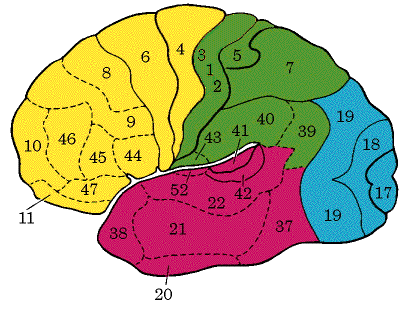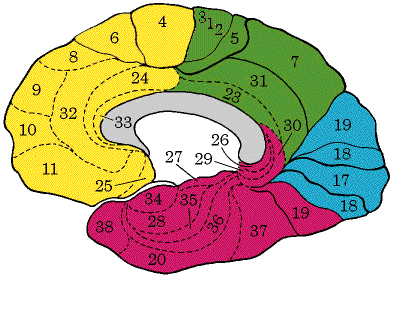
Sagittal view
 Frontal Lobe
thinking, planning, & central executive functions; motor execution
Frontal Lobe
thinking, planning, & central executive functions; motor execution
 Parietal Lobe
somatosensory perception
integration of visual & somatospatial information
Parietal Lobe
somatosensory perception
integration of visual & somatospatial information
 Temporal Lobe
language function and auditory perception
involved in long term memory and emotion
Temporal Lobe
language function and auditory perception
involved in long term memory and emotion
 Occipital Lobe
visual perception and processing
Occipital Lobe
visual perception and processing

Mid-sagittal view
The numbers superimposed on the above brain images are what
constitute the Brodmann's map of cytoarchitectonics. Brodmann
assigned numbers to various brain regions by analyzing each area's
cellular structure starting from the central sulcus [the boundary
between the frontal and parietal lobes]. The following table provides
a general view of brain function that refers to the Brodmann map.
Functional Areas of the Brain
| Function |
Brodmann Area |
|
| Vision |
primary
secondary |
17
18, 19, 20, 21, 37 |
| Audition |
primary
secondary |
41
22, 42 |
| Body Sensation |
primary
secondary |
1, 2, 3
5, 7 |
| Sensation, tertiary |
7, 22, 37, 39, 40 |
| Motor |
primary
secondary
eye mov't
speech |
4
6
8
44 |
| Motor, tertiary |
9, 10, 11, 45, 46, 47 |
As you may notice, many of the areas that are involved
in the same general cognitive functions are numbered sequentially
(or almost). This is no coincidence. For example, areas of the
brain that participate in motor control send more information
out to execute its commands than do areas involved in vision,
which receive more information than they send out. Areas that
perform the same tasks use essentially the same types of cells.
In general, information tends to flow from the back of
the brain to the front. The brain expends most of its energy packaging
sensory input from all available modalities into a coherent view
of the environment. Vision is combined with somatosensory information
to give a sense of where one's body is in space. Memory functions
in the temporal lobe allow for recognition of the visual perceptions.
The processed sensory input finally makes its way to the frontal
lobe where decisions are made regarding the various stimuli.


Frontal Lobe thinking, planning, & central executive functions; motor execution
Parietal Lobe somatosensory perception integration of visual & somatospatial information
Temporal Lobe language function and auditory perception involved in long term memory and emotion
Occipital Lobe visual perception and processing
